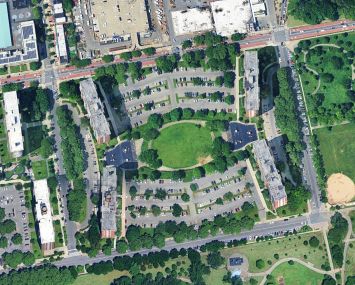Why Domino’s Soars in NYC While Pizza Hut Plummets
By Billy Gray December 10, 2013 10:05 am
reprintsDas Racist’s 2008 hit indie rap novelty song, “Combination Pizza Hut and Taco Bell,” a nonsensical ode to a stoner’s dream fast food pairing, specifically name-checked the stomach-churning combo’s branch at 160-01 Jamaica Avenue.
But while that location survives and 24 Taco Bells fan out across the boroughs, Pizza Hut maintains a low New York City profile, often conjoined with the ignominious Gordita crunch vendor in commuter hubs and down-at-heel outlying commercial corridors.

There are 16 Pizza Huts in the city, down from 20 in 2009, according to the Center for an Urban Future. Rival chain Domino’s has 70 stores spread out between each borough, whereas 10 of Pizza Hut’s locations are clustered in Queens. Domino’s local domination over Pizza Hut might surprise given Pizza Hut’s advantage in national popularity (roughly 6,200 stores vs. 4,939 Domino’s stores).
But despite the similar product and Domino’s being the clear runner-up nationally and internationally, the Ninja Turtles’ preferred pizza chain thrives here in part thanks to its focus on delivery over Pizza Hut’s sit-down model, which works in suburbia but is pricey in New York, where it also faces competition from local pizzerias.
“It’s a matter of each company’s franchising, the corporate cost involved or the price point of the product itself,” said Josh Siegelman, a broker at Winick Realty Group who focuses on restaurant transactions. If anything, the popularity of Domino’s (and Papa John’s, which has 65 NYC locations) is a surprise given the city’s cherished status as a real-deal pizza capital.
“New York, of course, is known for pizza,” Mr. Siegelman said. “I think these more generic brands are apprehensive about coming into the market.” Domino’s chief appeal is probably its low price—$5.99 for a medium two-topping pie, a price that so-called artisanal pizza parlors here might charge for a slice. It’s also open later—1 a.m. during the week, 2 a.m. on weekends—than your average corner pizzeria.
Chain geography is less pertinent to the Domino’s vs. Pizza Hut question than to other fast food rivalries. In-N-Out Burger, to the dismay of expat Californians, will not compete with McDonald’s (240 stores) for New York supremacy, since it’s not franchised and unmotivated to expand east. The Coffee Bean & Tea Leaf, a favorite of L.A. caffeine addicts, has entered the New York market but with none of the omnipresence of its paparazzi-stalked Southern California branches.
In-N-Out has somehow developed such a mythic reputation outside of California that visitors to the Golden State add it to their travel itineraries. The ubiquity of top-notch local New York pizza is yet another reason Mr. Siegelman cites for the reluctance of chains to inundate the city.
Representatives from Domino’s and Pizza Hut did not return requests for comment before The CO went to press.
“Tourists often look to eat at places with brand recognition,” he said. “That can bring them to Applebee’s or Five Guys. But one specialty item for New York is the slice. So the tourist sector is out. And locals are more sophisticated.”
How, then, to explain the proliferation of Subway stores (467, making it the second biggest chain in town after Dunkin’ Donuts) given the famous New York deli? “A lot of the deli guys got priced out,” Mr. Siegelman said. “And for whatever reason, people like the Subway model. It’s fast, and that model has always proven successful. People only wait as long as their eyes can see.”


